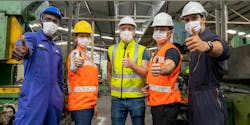4 Best Practices for Return-to-Work During COVID
Since early 2020, manufacturing has not been the same. COVID-19 has forced many manufacturers to close their offices and operate their factories differently. During the closures, leaders have been preparing for a return when it is safe and considering the best approaches for doing so.
Just ordering everyone back to work won’t do the trick. It’s about creating and maintaining a safe environment for healthy employees—and making sure that the sick recover at home. It’s also about appreciation and respect for factory workers: Valuing the work they are doing in those unprecedented times and genuinely making them feel the appreciation for showing up to work.
At Gartner, we speak to manufacturing leaders every day. Here are some of the strategies that have proven successful.
Create a Safe Work Environment and Appreciate On-Site Workers
While the internet is full of employees praising the merits of working from home, it’s important for leaders to acknowledge that not all jobs can be done remotely. The psychological effect on workers who show up for work, go through all the safety measures and then walk by empty meeting rooms and offices should not be underestimated. It’s a leader’s job to make the on-site staff feel safe—both mentally and physically—so they are just as engaged as their colleagues working from their homes.
Several leaders we spoke with did have employees test positive for COVID-19 early on and closed plants for deep cleaning, sometimes more than once. Now, commonplace practices include providing personal protective equipment (PPE) for all associates, using consistent teams per shift for better contact tracing, and striving to eliminate human touch.
Not to be overlooked as motivators for some associates to come onsite: one-time hazard bonuses, a small raise for hourly workers, or gift cards to local businesses.
Communicate and Ensure You Reach Everyone
Transparent and precise communication with frontline workers is crucial when protocols for social distancing, hygiene and navigating through the worksites are constantly changing.
Prior to COVID-19, messages would often be “lost'’ within organizational hierarchies. Now, organizations must nuance the communication around why they are doing something and what specific actions they are taking, to resonate with both hourly and salaried workforces.
For example, some organizations have partnered with their HR departments and created videos on “what your first day back will look like” to lessen any element of surprise and create psychological safety. It’s also a best practice to partner with regulatory bodies that can certify compliance with the changing requirements for workplace safety and communicate the reality of how infection can be prevented and not spread. This will provide clear illustration that you’re going above and beyond the basic regulatory requirements.
Collaborate with HR
Speaking of HR –it is the centerpiece of all COVID-19 activities that concern staff. And while in the past, manufacturing leaders’ default attitude regarding HR’s capabilities and usefulness was negative, things now look very different. Suddenly, HR is being lauded for providing communication strategies and modeling difficult conversations for leadership.
In some instances, manufacturing leaders were simply leaning on HR to help with insurance issues, payment policy for furloughed employees, sick leave policy and communications techniques. But it’s becoming more common for companies to embed HR in daily crisis management or war-room meetings. HR is providing valuable inputs for the decisions to reopen sites that span the management of government permits to re-start operations. A partnership between the global HR function and in-country HR teams is also a key focal point, as often the tools and engagement model in one geography are not transferable to another.
Just one more example where HR can help: Not every hourly worker has a company email, the same systems access, or consumes information in the same fashion as salaried associates. Manufacturing leaders must partner with HR to reach these employees differently and to find engagement paths for factory workers.
Prepare to Accelerate Change
Prior to COVID-19, organizations were already aggressively implementing their future digital designs for manufacturing. Not one company that we have spoken with is hitting the pause button on these endeavors. However, with accelerated technology usage and automation, along with removal of some physical supervisory oversight, many leaders said that operators will now have much more direct responsibility for productivity, quality, and safety. What this means: Investments are pivoting towards the people.
There is a big digital divide that needs to close, and operations leaders must rise to the challenge. Workforce flexibility is needed, as are training and upskilling. Sustaining the current engagement models with HR and enlisting its help to catalogue skills and competencies, institutionalize tacit knowledge, and cultivate learning and development plans for this new dynamic is critical. As staffing levels continue to fluctuate and shifts stagger, many leaders’ long-term focus will pivot toward organizational design—reassessing job families, team structures and human-machine collaboration models, and determining which roles are essential. This will inevitably change the balance of on-site and offsite staffing, and the overall factory talent profile.
The Path Forward
COVID-19 has put a stop to some manufacturing – but it didn’t stop the overall push toward digitization. It’s now more important than ever to maintain the right talent on the manufacturing floor by keeping people safe and upskilling them for the next step of the journey.
Simon Jacobson is vice president analyst, Gartner Supply Chain Practice.
